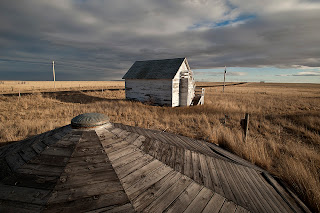A curtain hangs on a doorknob in an abandoned farm east of Chugwater, Wyoming. March 2012.
(click images for larger view)
Many photographers, myself included, are drawn irresistibly to places that humans have abandoned. Images of empty buildings in cities, stark farmhouses in the midst of abandoned fields, and neglected historic places like the immigrant intake buildings and hospitals of Ellis Island are common. Painters have gone down this road too; think of Andrew Wyeth's
Christina's World, with its farmhouse. The radio show
This American Life did
a story about kids exploring an abandoned house that appeared to have been vacated almost in an instant, with wallets left on bedside stands and dishes in the sink.
Tom Waits sang about them (thanks Melanie for this link).
The Onion even made fun of this obsession in
an article about artists documenting urban decay:
DETROIT—After spending more than a century exploiting urban decay to create deeply moving, socially conscious works of art, the art world announced Tuesday that it had captured all the beauty it was going to find in rusted-out cars, abandoned houses, and condemned industrial sites. "These modern ruins speak to the very heart of the human condition, but at this point every last inch of Detroit and Oakland has been documented in photographs, on film, or as part of a multimedia installation," said artist Devon Gerhart, who told reporters that devoting so much time to contemplating the wounded grandeur of blighted cityscapes had led him to the point where he just wanted to see the places cleaned up.
Why are we so interested in these places, and why do we keep photographing, painting, and telling stories about them even while recognizing the danger of feeding a cliche?
For me there is the fascination of exploring, without knowing what weird thing you might find: furniture arranged around a 1950s TV set with a wedding photo displayed on top of it; school books with handwritten notes to schoolmates scattered among decaying desks at a rural schoolhouse; clothes left hanging in closets; phone numbers chalked on the walls of a workshops; a kid's bedroom decorated with posters from the 1970s, with wind blowing off the prairie through broken windows. At an abandoned ranch in the Red Desert I found a baby's crib tossed into a coal room and a sunlight-damaged Big Wheel trike in the yard. What became of that ranch kid?
So these places are
interesting for the mystery of the lives that were lived in them and then abandoned for some other life.
I'll also never tire of the simple design of old farms and outbuildings. I love the porches and the wooden siding and the functional shapes, but also the subtle decorations--old curtains, beautiful doorknobs, simple fences. I love the way these places weather when left to fend for themselves. Wyoming is dry and little rots away, but it is also harsh, and the wind and snow and temperature extremes work to make houses sag and age, so that they blend with the grasslands around them, eventually to be swallowed up.
In a word, exploring old houses is
fun; cliches be damned.
I have a lot of images to post from just one weekend trip to Eastern Wyoming, and I hope to make more trips this spring. The photographs in this post are from an abandoned farm east of Chugwater that I had visited once before and revisited earlier this month.
A porch post at an abandoned farm east of Chugwater.
Too ironic to believe? Maybe someone set this up before me, but I didn't.
The wall above a workbench, in one of the outbuildings.
A hubcap in an outbuilding.
A workshop.
A window looking out an a covered porch.
Religion and horseshoes.
Dishtowel and dining room.


























